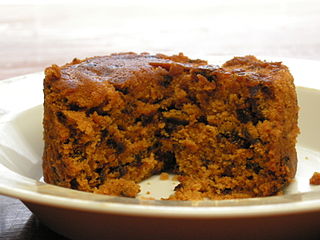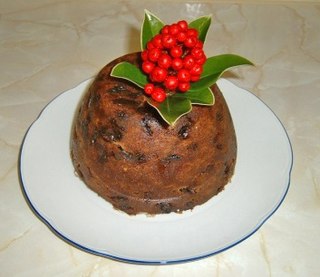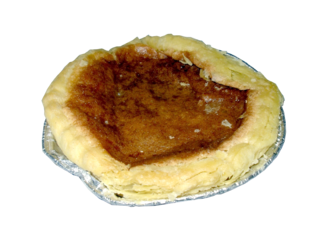
Yorkshire pudding is a common English starter dish, a baked pudding made from a batter of eggs, flour, and milk or water. It is a versatile food that can be served in numerous ways depending on the choice of ingredients, the size of the pudding, and the accompanying components of the dish. As a first course, it can be served with onion gravy. For a main course, it may be served with beef and gravy, and is part of the traditional Sunday roast, but can also be filled with foods such as bangers and mash to make a meal. Sausages can be added to make toad in the hole.

Trifle is a dessert found in English and other cuisines. Made with fruit, a thin layer of sponge fingers commonly soaked in sherry or another fortified wine, and custard, the contents of a trifle are highly variable; many varieties exist, some forgoing fruit entirely and instead using other ingredients, such as chocolate, coffee or vanilla. The fruit and sponge layers may be suspended in fruit-flavoured jelly, and these ingredients are usually arranged to produce three or four layers. The assembled dessert can be topped with whipped cream, or, more traditionally, syllabub.

Spotted dick is a traditional British baked pudding, historically made with suet and dried fruit and often served with custard.

Christmas pudding is a type of pudding traditionally served as part of the Christmas dinner in Britain, Ireland and in other countries where it has been brought by British and Irish immigrants. It has its origins in medieval England, and is sometimes known as plum pudding or just "pud", though this can also refer to other kinds of boiled pudding involving dried fruit. Despite the name "plum pudding", the pudding contains no actual plums due to the pre-Victorian use of the word "plums" as a term for raisins. The pudding has been heavily mythologized, including the erroneous idea that it is traditionally composed of thirteen ingredients, symbolizing Jesus and the Twelve Apostles, or that it was invented by George I. Early recipes include little more than suet, dried fruit, breadcrumbs, flour, eggs and spice, along with liquid which may be milk or fortified wine. Later recipes became more elaborate.

Toad in the hole or Sausage Toad is a traditional English dish consisting of sausages in Yorkshire pudding batter, usually served with onion gravy and vegetables. Historically, the dish has also been prepared using other meats, such as rump steak and lamb's kidney.

Bakewell pudding is an English dessert consisting of a flaky pastry base with a layer of sieved jam and topped with a filling made of egg and almond paste.

Treacle is any uncrystallised syrup made during the refining of sugar. The most common forms of treacle are golden syrup, a pale variety, and a darker variety known as black treacle. Black treacle, or molasses, has a distinctively strong, slightly bitter flavour, and a richer colour than golden syrup. Golden syrup treacle is a common sweetener and condiment in British cookery, found in such dishes as treacle tart and treacle sponge pudding.

Sri Lankan cuisine is known for its particular combinations of herbs, spices, fish, vegetables, rices, and fruits. The cuisine is highly centered around many varieties of rice, as well as coconut which is an ubiquitous plant throughout the country. Seafood also plays a significant role in the cuisine, be it fresh fish or preserved fish. As a country that was a hub in the historic oceanic silk road, contact with foreign traders brought new food items and cultural influences in addition to the local traditions of the country's ethnic groups, all of which have helped shape Sri Lankan cuisine. Influences from Indian, Indonesian and Dutch cuisines are most evident with Sri Lankan cuisine sharing close ties to other neighbouring South and Southeast Asian cuisines.

Apple crisp is a dessert made with a streusel topping. An apple crumble is a dessert of baked chopped apples topped with rolled oats and brown sugar. In the UK, Australia, and New Zealand, the term 'crumble' refers to both desserts, but in the US and Canada the two are distinguished.
Hasty pudding is a pudding or porridge of grains cooked in milk or water. In the United States, it often refers specifically to a version made primarily with ground ("Indian") corn, and it is mentioned in the lyrics of "Yankee Doodle", a traditional American song of the eighteenth century.

Steak and kidney pudding is a traditional British main course in which stewed beef steak and ox kidney is enclosed in suet pastry and slow steamed on a stove top.

Rag pudding is a savoury dish consisting of minced meat and onions wrapped in a suet pastry, which is then cooked in a cheesecloth. Invented in Oldham, the dish is also popular in Bury and Rochdale, and is eaten across the Greater Manchester area. Rag pudding pre-dates ceramic basins and plastic boiling bags in cookery, and so the cotton or muslin rag cloths common in Oldham were used in the dish's preparation during the 19th century. Rag pudding is similar in composition and preparation to steak and kidney pudding, and may be purchased from traditional local butcher's shops in Greater Manchester.
A suet pudding is a boiled, steamed or baked pudding made with wheat flour and suet, often with breadcrumb, dried fruits such as raisins, other preserved fruits, and spices. The British term pudding usually refers to a dessert or sweet course, but suet puddings may be savoury.

Sussex pond pudding, or well pudding, is a traditional English pudding from the southern traditional county of Sussex. It is made of a suet pastry, filled with butter and sugar, and is boiled or steamed for several hours. Modern versions of the recipe often include a whole lemon enclosed in the pastry. The dish is first recorded in Hannah Woolley's 1672 book The Queen-Like Closet.

Cabinet pudding, also known as chancellor's pudding or Newcastle pudding, is a traditional English steamed, sweet, moulded pudding made from some combination of bread or sponge cake or similar ingredients in custard, cooked in a mould faced with decorative fruit pieces such as cherries or raisins, served with some form of sweet sauce. Other versions of cabinet pudding might use gelatin and whipped cream.

Modern Cookery for Private Families is an English cookery book by Eliza Acton. It was first published by Longmans in 1845, and was a best-seller, running through 13 editions by 1853, though its sales were later overtaken by Mrs Beeton. On the strength of the book, Delia Smith called Acton "the best writer of recipes in the English language", while Elizabeth David wondered why "this peerless writer" had been eclipsed by such inferior and inexperienced imitators.

The Queen-like Closet, Or, Rich Cabinet was a cookery book published in 1670 by the English writer on household management, Hannah Woolley. It ran through five English editions by 1684. At least two German editions were also printed.

A Collection of above Three Hundred Receipts in Cookery, Physick and Surgery is an English cookery book by Mary Kettilby and others, first published in 1714 by Richard Wilkin.
















